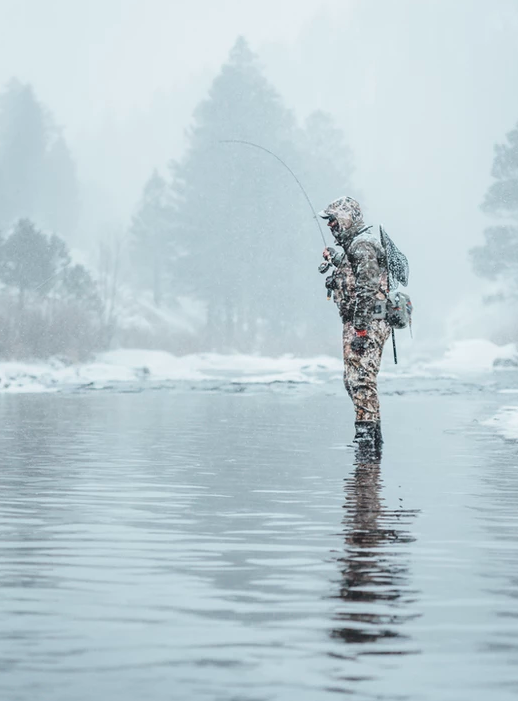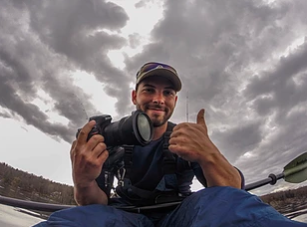
Fly fishing is certainly a niche genre when it comes to the world of photography, but with the increased use of social media, fly fishing photos and fish pics have become increasingly popular. With millions of amateur photos floating around Instagram and Facebook (ours included), it doesn’t take much for a professional fish pic to catch your eye. Rob Herrmann, a Colorado based photographer and fly fishing addict, caught our eye several months ago with his incredible fly fishing photography. We were so impressed with his skills (fly fishing and photography), we knew we had to get him on our FlyCast Ambassador team and pick his brain about photography. Thankfully, he said yes to both and we can now share his answers with you. Enjoy!
FlyCast: How long have you been doing fly fishing photography and how did you get into it?
Rob: I have been shooting just about everything I have laid my eyes on since my senior year of college. Fishing has been a passion of mine forever so naturally, the two collided somewhere along the way. I knew right away that fishing would be a large part of my personal photography work. The beautiful places and adventures that fishing lead me to were no brainers when it came to where and what to shoot.
When I moved to Denver I made it a goal to find a top notch guide service with a potential interest in having a photo/video creator along for the ride. Somehow the stars aligned just right and the first week into my stay here I was fortunate enough to meet a part of the staff with The Blue Quill Angler in Evergreen. They were gracious enough to let me tag along for a couple of trips to break the ice and the rest is history.
FlyCast: What is your favorite thing about this type of photography?
Rob: My favorite part would probably be how natural it feels. My love for fishing is second to none so it never feels forced when I'm on the water. As a creator, it's easy to lack inspiration at times. I'm happy to say that's rarely an issue when I'm out in nature. Whether the fishing is fast or slow, there's always something of interest to observe and shoot. The gorgeous places and wonderful people fly fishing has introduced me to are an important piece as well. The majority of people dedicating their time to fly fishing have a strong mutual respect for the lifestyle and the wonderful experiences that it presents us.
FlyCast: As an angler, is it difficult to watch someone else fish all day?
Rob: I get this question a lot and I always have to smile. After thinking about it enough, I'd say it's a bit of a mix. There's certainly times where I would love to have a rod in hand instead of the camera but I try to take a glass half-full approach. I truly believe that I easily learn three times as much from a day observing and shooting photos than I would if I was fishing. There's something to be said for the power of observation. I get to learn from others’ successes and more importantly, their failures. Missed sets, good sets, good casts, bad casts, how the fish react to certain presentations etc., etc. Often times, I also have a different vantage point as the photographer, provides me the opportunity to take in a lot more information than is even possible from the angler's perspective. Processing the photos after a trip is like going through the day's play book and reviewing all of the plays that worked or didn't work. Every trip behind the camera prepares me for my next encounter as the angler.
FlyCast: What is one of the most interesting things you've learned from photographing and observing guides?
Rob: It's a game of small adjustments. You can find out effective patterns from any good local shop, but being able to make the minor adjustments to make those bugs look delicious, is what makes or breaks people. One extra split shot, a dab of soft weight, two inches on your indicator, one size down in tippet. Strategic small adjustments until you find a recipe that seems to work. Those are the details that make guides so good at their jobs. Also, on that note, fly fishing guides are rock stars. People think it's a gravy lifestyle, but those guides work harder than you'll ever know to put fish in the net. Listen to them and trust what they coach you on. Do that, and you'll absorb years worth of knowledge from one guided trip.
FlyCast: How do you ensure you're in the right place at the right time to capture the big moments?
Rob: A lot of it is understanding the river and tuning into how the guide wants to approach each fish. Most of my favorite places to fish hold some seriously spooky trout. It's important to pick an engaging angle while being mindful of the potential of alerting that fish or any of his close compadres. I can't claim I'm always in the right place but I do my best to 'make it the right place'. You can get some epic shots both up-close and from a distance. No matter where you are in that range - take a second to process the full frame in front of you and make the best with what you've got. They're all great memories of better times by the end of the day.
FlyCast: Tell us about an unforgettable moment that you captured on camera?
Rob: It might be disappointing but the moment didn't even involve a fish. It was an 80-degree day on the Williams Fork. Plenty of fish throughout the day lead to a very special ending. A storm started blowing in from the distance and somehow managed to align itself perfectly with the sunset. The combination of the two painted a scene so vivid and beautiful I still find it hard to believe. There are few hobbies that would have led me to such a moment and for that, we should all be thankful.
FlyCast: What's the prettiest river you've shot photography on?
Rob: Totally subjective obviously but my encounters with the White River really stick out in my head. It's hard to go wrong with any of the canyons and tailwaters around though. It always amazes me how much beauty lies so close to the Denver area.
FlyCast: For those of us without fancy cameras what is your number one tip for taking photos with a phone?
Rob: Number one, don't think you need a fancy camera. Think outside the box and utilize the quality of close ups. Wide angle grip and grins are great at times but I find a lot of satisfaction in capturing the fish. Any cell phone these days can take a high-quality picture if you're fairly tight to the subject. Get creative with some close ups and maybe you'll create something you're excited about for years to come.
FlyCast: What tips do you have for taking photos with poor (cloud cover) or no lighting (night)?
Rob: Overcast days can actually offer some nice, even lighting for photos. Don't feel like you need direct light to get the shot. Identify your best light source and utilize it as best you can. You can also use natural reflectors to help add some fill lighting to your photos. Light surfaces underfoot, canyon walls or boulders behind and the water surface below can all supply you with additional lighting. Think about the light bouncing off of nearby surfaces and try to use it to your advantage. If you're shooting on an adjustable camera, give your ISO a bump and shoot as slow of a shutter speed as you can hold steady.
Night time is a tricky one. Whenever possible avoid using a front flash on a phone. If you have headlamps or lanterns, try to create a softer, more dispersed light rather than the harsh direct light created by a flash. If that's all you have then work with it. It's also very important to hold the camera steady at night due to longer shutter speeds (even on an iPhone!). Try tucking your elbows into your sides and hold your breath lightly while shooting.
FlyCast: If someone was interested in hiring you to take fly fishing photos, where can they learn more and contact you?
Rob: I run a wild schedule but I'm always open to inquiries and new challenges. You can feel free to reach out via e-mail, Instagram or my website. Whatever is easiest on your end. If you enjoy my photos feel free and drop me a line. I'm always excited to get out and capture the special moments that days on the water provide us.
Rob: Thanks for the chance to chat and tight lines!

Rob Herrmann
@rherrmannphotog
rherrmann55@gmail.com
www.robherrmann.com
